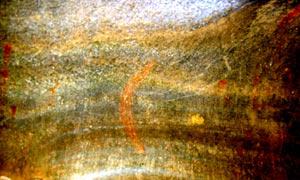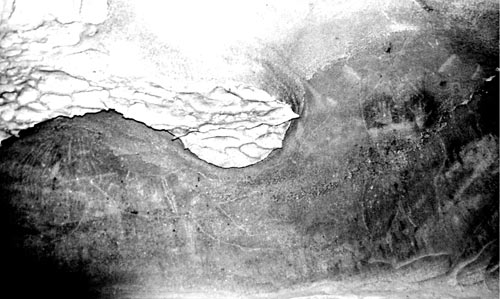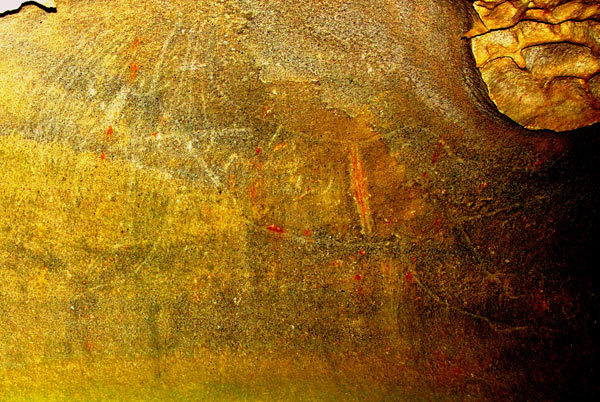Is this the Sistine Chapel of Pre-historic art?
Of all the constructions, engravings, paintings and Original sites we have seen, none were more remote or difficult to reach, or ever return to, than the Cave of the Golden Boomerang. Neither Evan or myself could get a fix on any landmark or ridge to cue off, we were totally lost and under the direction of our guides.
They assured us beforehand that this isolated outpost of Original rock art was as unique as it was magnificent, and in both respects this gallery did not disappoint. But even so, we were unprepared for scope, artistry and attention to detail on display. Until stepping into this region and sighting this stone panel of figures in motion and devotion, we had accepted the scholar’s assertion in identifying specific regional Original styles, and that all forms of Original artistic expression cover a broad range, but fall well short when it comes to representational depictions of the human body.
 The closest and supposedly only example of any pre-Cook art that verges on the representational is referred to as ‘Bradshaw Art,’ and explanations are varied with some condescending in the extreme. Some commentators, which includes self-proclaimed Kimberleys rock art ‘expert,’ Graham Walsh, are adamant that this form of ancient art is too sophisticated and refined for the crude Original palette. Given that ‘fact,’ Walsh and others assumed that the Bradshaw ochre paintings were created by non-Original people who sailed to Australia, painted in caves, and then departed without a trace or any substantiating historical evidence.
The closest and supposedly only example of any pre-Cook art that verges on the representational is referred to as ‘Bradshaw Art,’ and explanations are varied with some condescending in the extreme. Some commentators, which includes self-proclaimed Kimberleys rock art ‘expert,’ Graham Walsh, are adamant that this form of ancient art is too sophisticated and refined for the crude Original palette. Given that ‘fact,’ Walsh and others assumed that the Bradshaw ochre paintings were created by non-Original people who sailed to Australia, painted in caves, and then departed without a trace or any substantiating historical evidence.
The Cave of the Golden Boomerang
Thousands of kilometers to the south of the Kimberleys, this gallery spans over 20 metres and is over 4 metres high. There are six figures/icons engraved and painted on the sandstone wall: two women (one standing the other floating or flying), one unarmed male, an infant, one boomerang and a Tasmanian Tiger (Thylacine). It is widely claimed the Tasmanian Tiger has been extinct on the Australian mainland for at least 5,000 years, and as such, provides a reliable minimum date.
Each human figure is larger than life size (approx. one and a half) and directly proportional. Such is the attention to detail that thousands of years after creation it is still possible to identify the banding on the males’ arm creating a slight depression in the flesh, the arch in the floating woman’s foot, the depiction of each finger, a very unusual dreadlocked hair style, curvature of the hips, calf and buttocks, etc. The artist has gone to great lengths to replicate the same proportions, line and shape of the human body. It is plausible to claim, but impossible to prove, that if actual models were used, this group rendition was exact down to the millimetre. None of the Bradshaw figures are anywhere as proportional or large, and in comparison they are elongated stick figures with a hint of body shape.
 Residual traces of ochre, nearly all of the most sacred category, red, can be found throughout the panel. The two most prominent areas of red colouring are inside the boomerang, which is the thickest, and the outer section of the two circles on the waist of the standing woman. What was interesting was the outcome of Evan’s application of different colour filters to the photograph of those circles, until then no-one had seen the hand stencils inside each red ochre circle. Whether applied at the same time, or after is debatable, but the fact that none of us on the day saw the hand prints either on site or when viewing then normal photographic images, only reinforces the incredibly secret sacred nature of this cathedral.
Residual traces of ochre, nearly all of the most sacred category, red, can be found throughout the panel. The two most prominent areas of red colouring are inside the boomerang, which is the thickest, and the outer section of the two circles on the waist of the standing woman. What was interesting was the outcome of Evan’s application of different colour filters to the photograph of those circles, until then no-one had seen the hand stencils inside each red ochre circle. Whether applied at the same time, or after is debatable, but the fact that none of us on the day saw the hand prints either on site or when viewing then normal photographic images, only reinforces the incredibly secret sacred nature of this cathedral.
The narrative that accompanies this gallery is no less profound or sacred than that associated with the paintings on the ceiling of the Sistine Chapel, and no less than a dozen times older. There is a pronounced feminine undertone with two women, one newly born baby and an unarmed male reaching towards, but not touching, the symbol representing illumination. The liberal use of bands, belts and diagonal sashes adds to the sacredness of this occasion. In its prime, over 5,000 years old and fully painted up, we firmly believe this rock art gallery was unparalleled in its artistry and mystical insights, not only in Australia, but throughout the planet.
A Pattern Repeated
 It has always been our contention that fully modern human beings first evolved in Australia, then sailed from this continent to share their wisdom, technology, culture and genes with people throughout the world. Among their many talents, they were the first artists and mastered all styles and mediums from abstract, symbolic, hatched, dotted and exaggerated, all the way through to representational. The Cave of the Golden Boomerang merely illustrates how diverse and incredibly gifted the Original artists were, and how little of the real Original history is the currency of these days.
It has always been our contention that fully modern human beings first evolved in Australia, then sailed from this continent to share their wisdom, technology, culture and genes with people throughout the world. Among their many talents, they were the first artists and mastered all styles and mediums from abstract, symbolic, hatched, dotted and exaggerated, all the way through to representational. The Cave of the Golden Boomerang merely illustrates how diverse and incredibly gifted the Original artists were, and how little of the real Original history is the currency of these days.



















